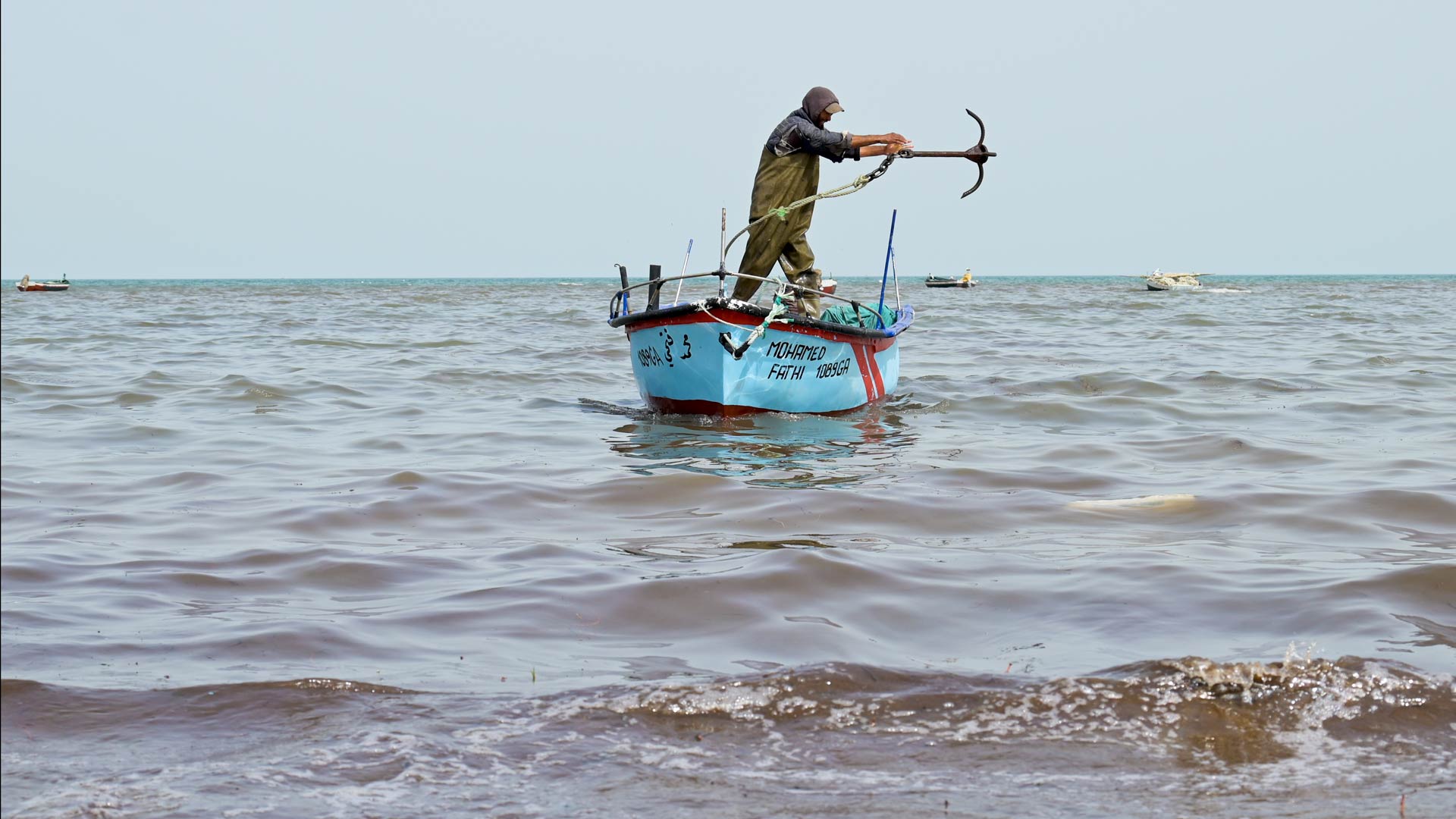On April 16, 2022, the Xelo oil tanker ran aground off the Gulf of Gabes. The oil, which most likely originated from the engine, leaked from the ship, but was contained by a boom during the emergency response. Gabes, April 19, 2022. Photograph by Morgane Wirtz / Hans Lucas.
The circumstances surrounding the sinking of the Xelo tanker are suspicious. Apparently, the ship, which was previously known as Liman, had recently changed its name, and there is a lot pointing to the fact that it was a smuggling ship. that it was a smuggling ship. Gabes, April 19, 2022. Photograph by Morgane Wirtz / Hans Lucas.
A sailor from the Gabes port jumped into the water to help his colleagues install a safety boom around the shipwreck to prevent an oil spill. He spent nearly an hour swimming in the 18°C water. Gabes, April 19, 2022. Photograph by Morgane Wirtz / Hans Lucas.
Despite the boom that was installed around the Xelo shipwreck, a small amount of oil still leaked into the water. Fathi, a fisherman, observes the phenomenon. Ghannouch, April 20, 2022. Photograph by Morgane Wirtz / Hans Lucas.
Arif, also a fisherman, observes the thin layer of oil that accumulated on the surface of the sea as the result of the Xelo shipwreck. Ghannouch, April 20, 2022. Photograph by Morgane Wirtz / Hans Lucas.
The Fathia crew just returned to the Gabes port. At sea, they spotted oil spills from the wreck. "We are happy with what we fished today, but our work is really hard", says Alweer, one of the fishermen. Gabes, April 21, 2022. Photograph by Morgane Wirtz / Hans Lucas.
A fisherman carries two crates of crabs to the beach. Nicknamed "Daesh", this new species is very invasive. The crabs damage the fishing nets and harm the cuttlefish and shrimp, making them unmarketable for the fishermen. However, they decided to catch them as well, and are now making a profit off of them. Ghannouch, April 20, 2022. Photograph by Morgane Wirtz / Hans Lucas.
Fathi, who has been fishing since he was a child, laments the destruction of the seabed. "There used to be a lot of fish. Now it's decreasing every year", he says. Ghannouch, April 20, 2022. Photograph by Morgane Wirtz / Hans Lucas.
With or without the shipwreck, the Gulf of Gabes is very polluted, mainly because of the Groupe Chimique Tunisien, which has been processing phosphate since the 1970s. The smell is foul for several kilometres surrounding the chemical port, and it is hard to breathe. Gabes, April 19, 2022. Photograph by Morgane Wirtz / Hans Lucas.
Every day, 42,000 cubic metres of phosphogypsum mixed with fresh water is discharged into the Mediterranean Sea by the Groupe Chimique Tunisien, according to the Tunisian Southern Wetlands Protection Association [Association sauvegarde des zones humides du Sud tunisien]. Gabes, April 20, 2022. Photograph by Morgane Wirtz / Hans Lucas.
The once white beaches of Gabes are now black, covered in phosphogypsum. "If you do an analysis, you'll probably find some sand in this", one sailor joked. All this pollution has a major impact on biodiversity. Gabes, April 21, 2022. Photograph by Morgane Wirtz / Hans Lucas.
The pollution affects the vegetation and the soil as well as the sea. Pollutants have been found in the leaves and branches of trees throughout the region. A few kilometres from Ghannouch, the Gabès oasis (the only coastal oasis on the Mediterranean Sea), is dried up, decimated by the Groupe Chimique Tunisien. Ghannouch, April 20, 2022. Photograph by Morgane Wirtz / Hans Lucas.
A lot of waste is dumped on the beaches of the Gulf. Gabes, April 20, 2022. Photograph by Morgane Wirtz / Hans Lucas.
Ammar and his co-workers sort their fishing nets in the Gabes port. Gabes, April 21, 2022. Photograph by Morgane Wirtz / Hans Lucas.
Mongi, a captain in the Gabes port, repairs his nets. "We haven't passed anything on to our children", he laments. "Our parents wanted us to become fishermen. But today, we don't want our children to be fishermen." Gabes, April 21, 2022. Photograph by Morgane Wirtz / Hans Lucas.




